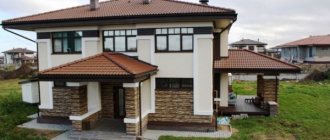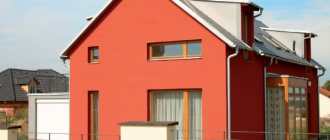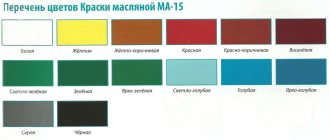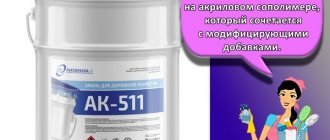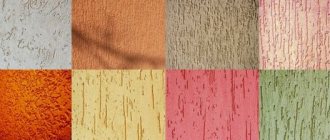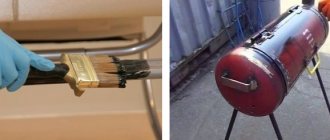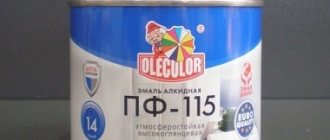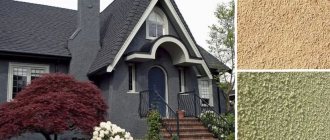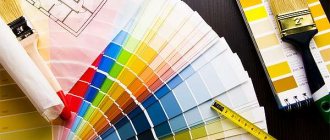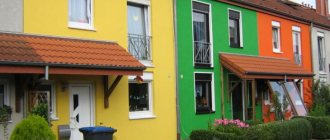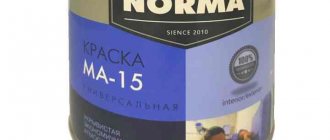Finishing work serves two main purposes. The first, the most obvious and the main one for most, is the creation of a decorative shell, an elegant external appearance of the building.
The second task lies in the plane of materials science and does not appear outwardly in any way, but its importance does not decrease from this. This is the protection of wall materials from the adverse effects of atmospheric moisture, low temperatures and other factors that pose a threat to building materials.
The very first layer that takes the maximum load is the façade paint, which serves as a protective barrier for all wall materials. The durability of all exterior finishing depends on its quality and performance characteristics, which ultimately determines the frequency and amount of costs for cosmetic repairs.
Features of XB-161
HB 161 perchlorovinyl facade paint, grade A B, is selected when the outside of the house should be painted in order to create a protective layer against the harmful effects of natural factors. The product can be used on different types of substrates, including concrete, wood, building stone, plasterboard, brick. In addition to reliable protection, the coating will have a good appearance and a matte effect.
The composition contains harmful elements, therefore, when used inside a building, good ventilation must be created.
In addition to reliable protection, the coating will have a good appearance and a matte effect.
Specifications
This paint and varnish material has excellent performance properties. Here are the main technical characteristics of XB-161 paint:
- high resistance to aggressive substances, chemical products, petroleum products, including gasoline, oil, etc.;
- resistance to the harmful effects of atmospheric conditions, heat and frost. The paint can be used in a temperature range of 20...+40 degrees;
- volume of non-volatile components – from 43 to 47%;
- Drying period – about 4 hours;
- the elasticity index of the dried layer for bending is 5 millimeters;
- resistance to sudden temperature changes - 10 cycles;
- scope of application – painting facades made of brick, concrete, plaster, wood and metal processing is allowed;
- frost resistance - more than 50 cycles.
Various perchlorovinyl facade paints are made, of which XB-161 has the highest percentage of non-volatile components; it can be applied at sub-zero temperatures. In addition, this paint and varnish material has excellent adhesion to almost all types of modern building materials, which is why XB-161 is a very popular and in demand paint.
Description, composition, GOST
The components used in the product are perchlorovinyl resin, fillers and dyes. The resulting layer is distinguished by its strength, serving as effective surface protection and versatility.
Perchlorovinyl paint GOST 25129-82 regulates the production of these products. Therefore, when purchasing, it is necessary to check the availability of certificates of conformity and quality from the seller. The peculiarity of the composition is its resistance to high-temperature influences, and low-temperature ones too; it does not harden at -20 degrees. This allows painting in both hot and cold weather.
A wide range of color solutions makes it possible to choose the best option for painting the surface. Allows the walls to “breathe”, creates an elastic coating, and reduces the effect of moisture on the base.
A wide range of color solutions makes it possible to choose the best option for painting the surface.
Description and scope of application of paint
Perchlorovinyl facade paint XV-161 is made from PVC resin, which is a binding component, also containing synthetic or natural fillers, pigments and an organic solvent, for example, xylene or solvent. This perchlorovinyl paint is a durable finishing paint composition that is highly durable and has many valuable qualities.
XB-161 is a universal paint and varnish material. This paint can be used for application on brick, concrete walls, plaster, metal and wooden surfaces. HB-161 enamel can be used for exterior work when processing facades for residential and non-residential purposes, including houses, office premises, industrial workshops, etc. This composition is quite decorative; it creates an attractive matte protective layer with a rich tint.
This perchlorovinyl paint is manufactured in accordance with GOST 25129-82. It has a high resistance to extremely low temperatures, it does not freeze in frosts down to -20 degrees, thanks to this property the scope of its application is significantly expanded. XB-161 is manufactured in a wide color palette; approximately 25 shades are available to the user. The color of the painted surface is not affected by ultraviolet rays, does not fade in the sun, and therefore remains unchanged throughout its entire service life.
Perchlorovinyl paint and varnish material has an excellent set of characteristics that are so necessary for exterior finishing; it is water-repellent, elastic and vapor-permeable. In addition to its use for painting facades, another area of application for PVC paint XB-161 is the processing of metal structures, ship materials, and other products and structures operated in difficult and aggressive conditions. Each batch is accompanied by a certificate of conformity for XB-161 paint, which confirms that the products are of high quality. Paint consumption per square meter is approximately 270 g, provided that the layer thickness is about 25 microns.
Additional information about paint grades A and B
The products are characterized by high levels of resistance to environmental factors, resistance to oils and gasoline, and good wear resistance. To allow moisture to easily pass through the coating, it is endowed with the property of vapor permeability. Consumption for A is approximately 180 grams per square meter, for B 150 grams per square meter.
If necessary, the enamel can be tinted to obtain the desired shade. The layer will remain on the surface for about three years.
The products are characterized by high levels of resistance to environmental factors, resistance to oils and gasoline, and good wear resistance.
Details
Pros and cons of the product
Among the advantages we can highlight other useful properties of the product:
- There is no need to pre-treat the surface before painting, and there is no need to apply a primer to the base.
- Penetrates deeply into the structure of the building material, due to which it will firmly adhere to the surface of the wall, strengthens the base and helps to reliably protect it from the negative effects of the atmosphere.
- Available in the form of a one-component mixture, completely ready for use. The paint has an optimal working viscosity, and therefore it can be immediately applied to the surface of the walls without dilution, for example, using a sprayer.
- It can be tinted in any shade, and there are approximately 25 options available, allowing you to implement all design solutions for every taste.
- The manufacturing company offers a wide range of colors and saturation of all shades.
- The product is universal and can be applied to all types of surfaces.
- The paint can withstand frost without problems; it can be used to treat walls at temperatures from -15 to -20 degrees.
- The color of the paint will remain unchanged for three years and will not be affected by ultraviolet radiation.
- You can paint metal products and not worry about corrosion or even rust appearing on the surface.
- The dried layer will be elastic, due to which it is able to retain its properties during vibration of the structure, shrinkage or even movement.
- The painted coating will have a high vapor permeability, due to which the façade of the building will “breathe”.
- Low cost of material.
Despite the advantages of façade paint XB-161, there are certain disadvantages:
- An unpleasant and pungent aroma that will be present when the paint solution is applied and dried, which is why it is worth using protective equipment, for example, a gas mask or a respirator, and especially if the painting is carried out by spraying.
- The material is flammable and highly flammable, and therefore you should have fire extinguishing equipment with you.
- The solution should not be mixed with plain water.
- Although the dried painted layer has excellent elasticity, it is not sufficient, and therefore it is recommended to paint only the most even walls, since otherwise the paint will begin to crack.
- It is not allowed to carry out painting work in very hot weather, or when it is raining or heavy fog outside.
Please note that if painting is carried out in hot summer weather, at temperatures above +36 degrees, then the paint should not be allowed to dry quickly. To do this, it will be mixed with a small amount of soap, due to which the applied coating will not crack as it dries.
Technical properties
This paint and varnish material has excellent performance properties. Here are the main technical properties of the paint:
High resistance to aggressive substances, petroleum products, chemical products, including oil, gasoline, etc.- Resistance to the harmful effects of atmospheric conditions, frost and heat. The paint can be used at temperatures ranging from -20 degrees to +40.
- The proportion of non-volatile components is from 42 to 48%.
- Drying time is approximately 4 hours.
- The elasticity of the dried layer at the bend is 0.5 cm.
- Resistance to sudden temperature changes is about 10 cycles.
- Scope of application – painting of brick, plaster, concrete facades; processing of metal and wood is allowed.
- Frost resistance – more than 50 cycles.
Manufacturers create various perchlorovinyl facade paint and varnish compositions, and of these, perchlorovinyl paint XB-161 has the highest percentage of non-volatile components, and it can also be easily applied at sub-zero temperatures. Moreover, this paint and varnish material has an excellent degree of adhesion to almost all types of modern building materials, and therefore this paint is in demand and popular.
Advantages and disadvantages
Enamel XB 161 is characterized by a number of advantages, but it also has disadvantages. The substance has a large number of advantages, these include the following features:
- It is possible to paint the wall without a preparatory stage;
- It has a deep-penetrating property, so the material is strengthened;
- You can work with a brush or spray;
- No dilution required before application;
- Frost resistance;
- Resistance to ultraviolet radiation;
- Protects metal products from rust formation;
- Elasticity.
The downside is that the product is flammable, application must be carried out in accordance with fire safety rules, and it emits a pungent odor.
It is possible to paint the wall without a preparatory stage.
Application area
Perchlorovinyl enamels of grade A are used for finishing the facades of buildings that have concrete, brick or plastered walls. Grade B enamel is a material used to paint important architectural structures.
The enamel should only be applied to a flat, clean and dry surface that does not have loose plaster or cracks. If organosilicon, lime, silicate, or acrylic materials were used to paint surfaces, they must be cleaned before applying perchlorovinyl enamel. Painting of walls is not carried out if their temperature is less than 5 degrees.
Perchlorvinyl facade paint HV 161: characteristics
Enamel XB 161 technical characteristics are responsible for the positive aspects that are inherent in the resulting coating. The following technical characteristics are noted:
- You can work at temperatures from +40 to -20;
- Withstands exposure to chemicals;
- Dry residue – 43-47;
- Drying time is four hours.
You can work at temperatures from +40 to -20.
Other types and manufacturers
Perchlorovinyl type of dyes are available in different markings. In accordance with the markings, they can be used for various situations. There are the following types:
- 125, applied without the use of a primer solution, suitable for processing metal structures or wood structures. For metal, UR 1161 enamel can also be used;
- 182, it is recommended to prime the surface before painting, designed for decorative painting;
- 161, a frost-resistant species, is applicable in temperate climate zones.
In the construction market, the companies most often purchasing funds are PKF Spectr and NPF Emal.
In accordance with the markings, they can be used for various situations.
What surfaces is perchlorvinyl paint suitable for?
This product is chosen if you need to paint the facades of houses, other buildings, and production workshops. The base can be made of various materials. Can be used for painting concrete, wood, plasterboard, brick, and building stone.
This product is chosen if you need to paint the facades of houses, other buildings, and production workshops.
Technology of façade cladding with perchlorovinyl paint
The master needs to protect himself before applying the product; for this, PPE is worn. The surface coating technology includes the steps described below:
- The wall is cleaned and leveled. If there is plaster on the base that does not adhere well, then it is removed. Defects are smoothed out with a special solution;
- Objects that may be damaged by painting are dismantled;
- Painting should be done in dry weather, the walls should be dry, paint should be applied to areas where ultraviolet radiation does not touch. This requires gradual coloring of only those areas that are in the shade;
- At low temperatures, it is unacceptable to use water to impart the required viscosity; replace it with solvent or xylene;
- Application is carried out using conventional painting tools.
You can paint over old paint with perchlorovinyl.
Painting should be done in dry weather, the walls should be dry, paint should be applied to areas where ultraviolet radiation does not touch.
Paint consumption per m2
In order not to buy a ton of extra product, you should calculate the consumption. It is influenced by the thickness and number of layers, the type of base, and the chosen painting tool. If the base has a rough structure, then more product will be needed; if it has a smooth structure, then less.
The average is 150-200 grams per square meter. m. area. If you intend to apply two layers, then 500-600 grams.
If the base has a rough structure, then more product will be needed; if it has a smooth structure, then less.
Recommendations for use and application
In order to obtain the desired result, you should take into account the advice of specialists when painting yourself. It is recommended to place the substance in a building at room temperature for 12 hours before use. It is advisable to apply varnish before painting; varnish XB148 is suitable. You can add diluent no more than 10% of the total volume. The second layer is applied 24 hours after the first.
It is advisable to apply varnish before painting; varnish XB148 is suitable.
XB 161 is a paint that helps solve two problems at once - creating a beautiful decorative layer and protecting the facade. To get a high-quality result, you need to purchase the product from a trusted place and ask the seller for a certificate of quality and conformity. Painting is not difficult, you can do it yourself.
Application of material
Although applying HB paint is similar to painting with other dyes, it still has its own characteristics. First of all, this paint needs to be kept at room temperature for 8–12 hours to make it less viscous.
The surface to be painted must be free of dirt, grease stains and dust. It should also be smooth, for which you can use putty. Before applying paint, it is recommended to varnish the surface (for example, XB-148 varnish is suitable).
The paint must be stirred well throughout the entire working process, otherwise it will quickly thicken. If the composition nevertheless thickens, the question arises: how to dilute the paint? Xylene or solvent is suitable for this purpose. Measurement is important here: the specific gravity of solvents should not exceed a tenth of the total volume.
XB-161 is applied in two layers. The first is almost completely absorbed into the material being painted, but the second provides color depth, that is, a decorative effect. The break between applying layers is at least 24 hours.
